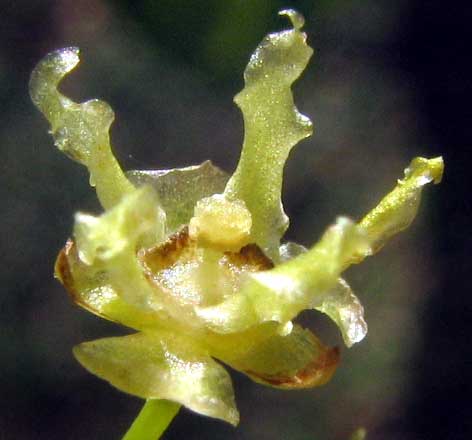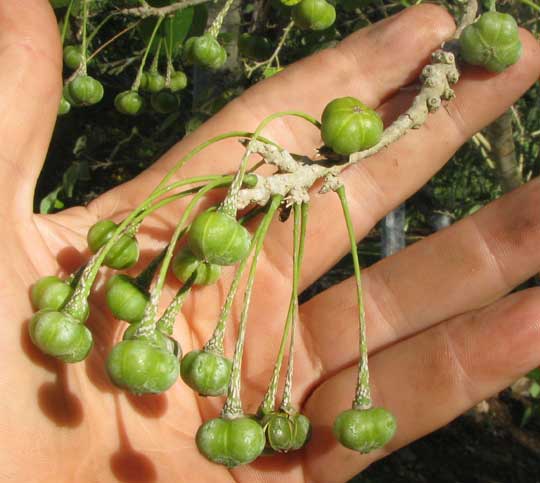Excerpts from Jim Conrad's
Naturalist Newsletter

from the March 6, 2011 Newsletter issued from Hacienda Chichen Resort beside Chichén Itzá Ruins, central Yucatán, MÉXICO; limestone bedrock, elevation ~39m (~128ft), ~N20.676°, ~W88.569°
ASTROCASIA FLOWERING & FRUITING
A small, very common tree here, about the size of a northern Redbud tree, is flowering and fruiting now. It's particularly interesting to me because it's unlike anything I've ever seen. A branch showing clusters of mouse-eye-size flowers, and leaves with petioles seemingly too long and stiff for them is shown above.
A close-up of a yellow flower is shown below:

One reason the flower looks so peculiar is that it is unisexual, bearing only female parts; stamen-bearing male flowers occur on separate trees.
Clusters of green, three-sided fruits dangle on the same tree as the above flowers appear on, shown below:

The fruits appear to remain green until ripe, when the leathery husk splits into sections revealing three hard, bony seeds inside, as seen below:

This is ASTROCASIA TREMULA, apparently having no name in English or Spanish, but known to the Maya by several names, including X Kay Yuc.
Whenever you see a three-sided fruit like that on a tree that's obviously an angiosperm, and the flowers are unisexual, you should think "Euphorbia Family" -- Euphorbiaceae, which is Astrocasia's family.
So many Astrocasia tremulas grow on and around the Hacienda's grounds that you assume that they're very common weed trees. However, Astrocasias are seldom heard of by non-specialists. The genus occurs only in tropical America, and includes only five species. Our species, Astrocasia tremula, is found only in widely separated, or disjunct, populations -- in the Greater Antilles, the Yucatan Peninsula, western Mexico, Panama, and Venezuela. Did the species once cover the whole area from Mexico to Venezuela, but then something such as a disease killed most of them out, leaving only these scattered populations? No one knows.